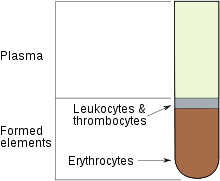THE BLOOD
Components of the Blood

[Photo credit: Messer Woland]
The blood is a tissue, in form of a fluid. It is a means of transport in man. An adult human being has about 5-6 litres of blood, running in their vessels. The blood is made up of two major components:
- Blood cells
- Plasma
There are three types of blood cells:
- White blood cells (leucocytes)
- Red blood cells (erythrocytes)
- Blood platelets (thrombocytes)
White Blood Cells (Leucocytes): White blood cells are also referred to as leucocytes. They are irregular and amoeboid in shape. They are large and colorless. They are larger than the red blood cells in diameter, and also fewer in number than the red blood cells. About 5,000-10,000 of them exist in a cubic mililitre of blood. They contain nucleus. They are made in red bone marrow and can live for man months.
White blood cells are two types:
(i) Phagocytes: These are located in the lymphatic system, where they ingest viruses, bacteria and dead cells. They also help in preventing diseases. This ingestion of materials is referred to as phagocytosis.
(ii) Lymphocytes: These are made in the lymph glands. They produce antibodies. The antibodies they produce stick to the surface of germs and kill them.
The main fnuction of white blood cells is that they help to defend the body against diseases by ingesting the bacteria and virus that cause them.
Red Blood Cells (Erythrocytes): Red blood cells are also referred to as erythrocytes. They are small, round and binocave or disc-like in shape. They do not have nucleus. Their life span is about 120 days, before the liver destroys them. They are mainly produced by the bone marrow. One cubic litre of blood consists of about 5.5 million red blood cells. They are red in color because of the presence of iron compound known as haemoglobin.
The hemoglobin helps in the transport of oxygen from the lungs to the body cells. It combines readily with oxygen to form oxyhaemoglobin in the lungs.
Blood Platelets (Thrombocytes): Blood platelets are also referred to as thrombocytes. They are tiny, irregular cell fragments. They do not have nucleus. They are smaller and fewer than the red blood cells, 250,000-400,000 per mm3 of human blood.
The function of blood platelets is that it aids in the clotting of blood.
2. Plasma
The plasma is the liquid component of blood. It consists of 90% water. It is pale yellow in color. Many substances dissolved in it include:
- antibodies
- proteins
- enzymes
- hormones
- gases
- salts
and so on.
The main function of plasma is that it helps to transport the substances that are dissolved in it as well as the cells that float in it.
Functions of the Blood
The functions of blood include:
- transport of oxygen
- transport of digested food
- transport of excretory products
- transport of hormones
- temperature regulation
- transport of water
- production of antibodies
- blood clotting
- defence against infection
This is a liquid, associated with the lymphatic system. It is colorless. It is in form of a fluid. It is similar in composition to the tissue fluid, but it contains extra lymphocytes. Red cells are not present. Movement of the lymph is enhanced by the action of muscles. It moves through vessels, e.g lacteal. Some swelling do exist in groups along the lymph vessels especially in the neck, groin and armpit, called lymph nodes. The lymph nodes are where lymph passes through the to be made pure before entering into the blood stream. The lymphatic system is second to the circulatory system. But unlike the circulatory system, it ends blindly.
Functions of the Lymph
The functions of the lymph include:
- body defence: The lymph node produces white blood cells, hence aids body defence.
- absorption of fatty acids and glycerol









0 comments:
Post a Comment